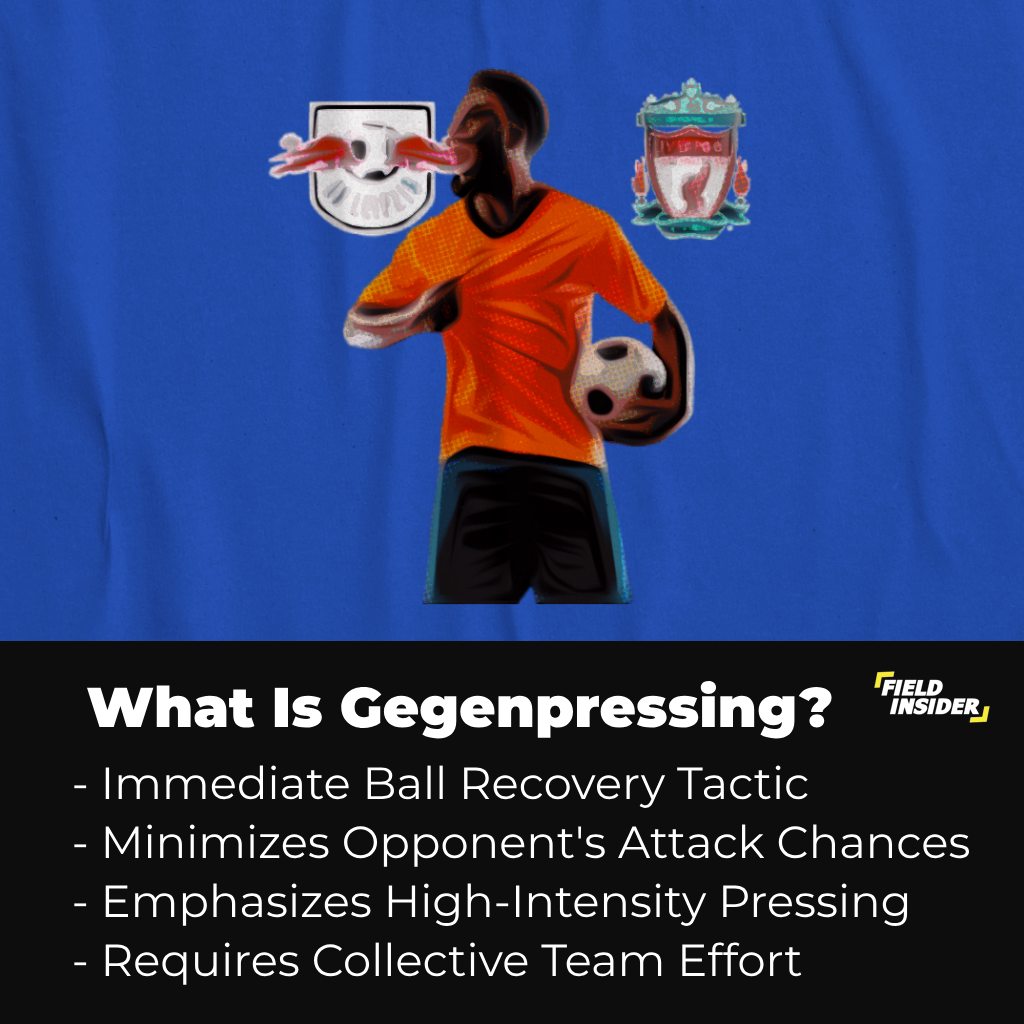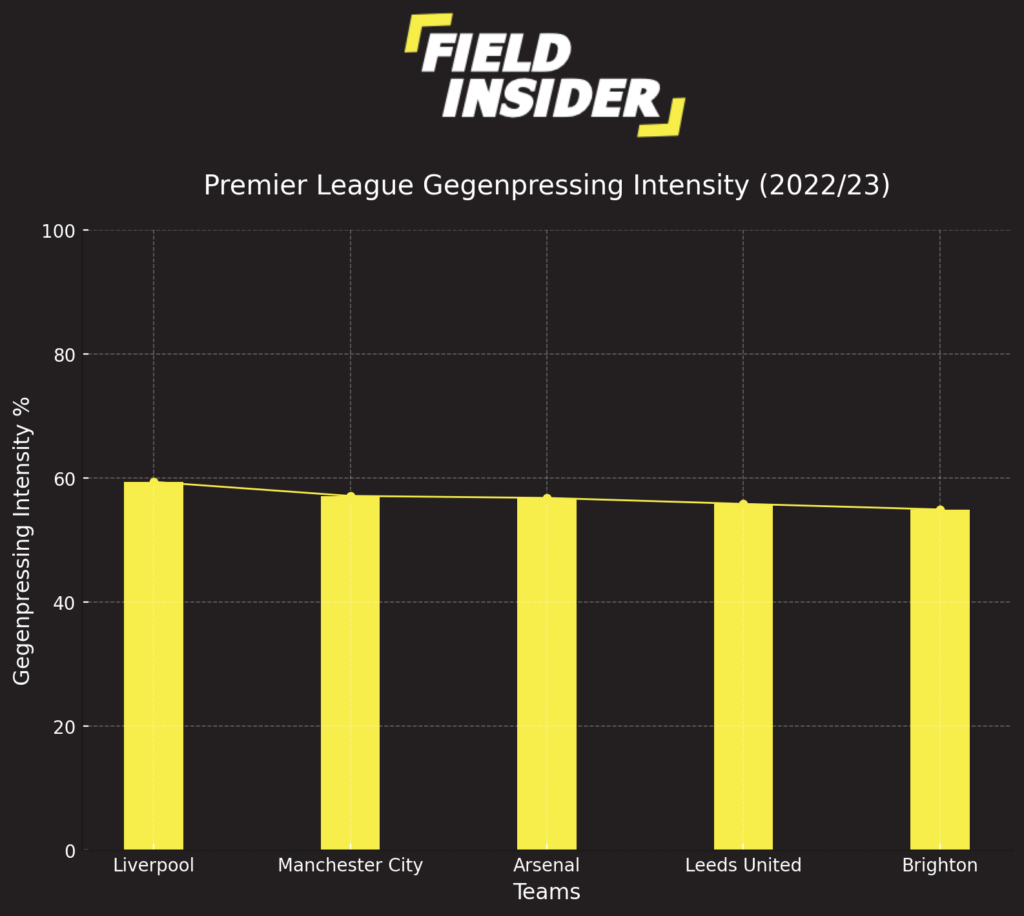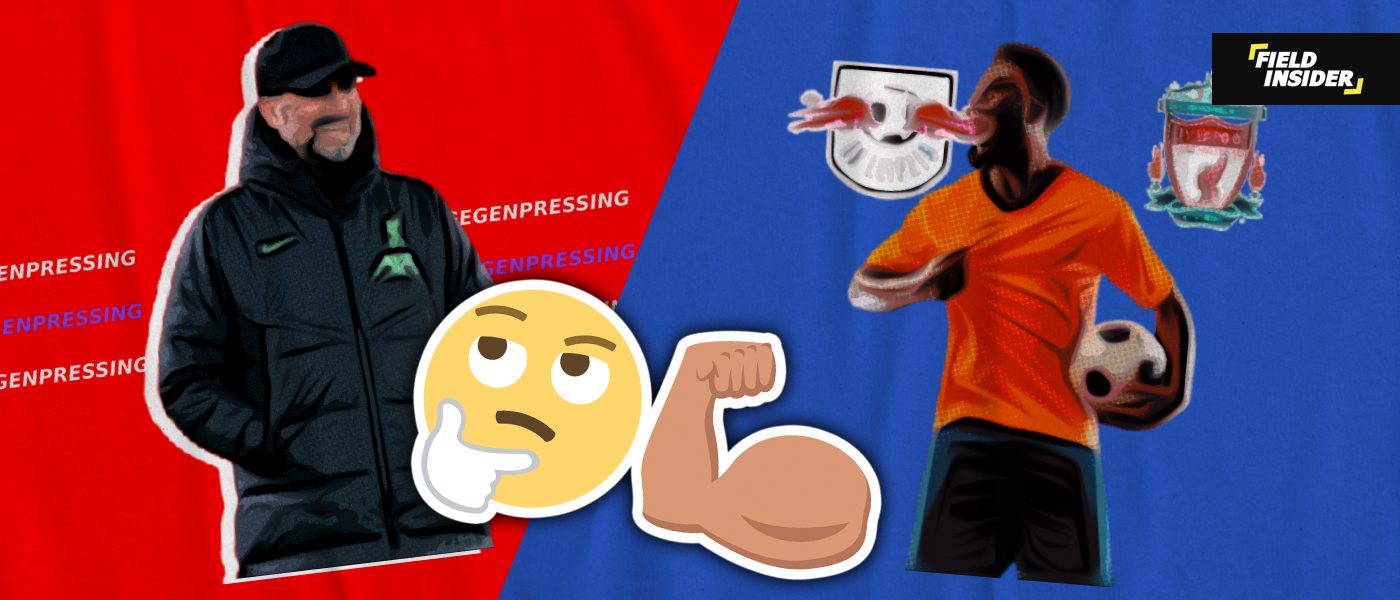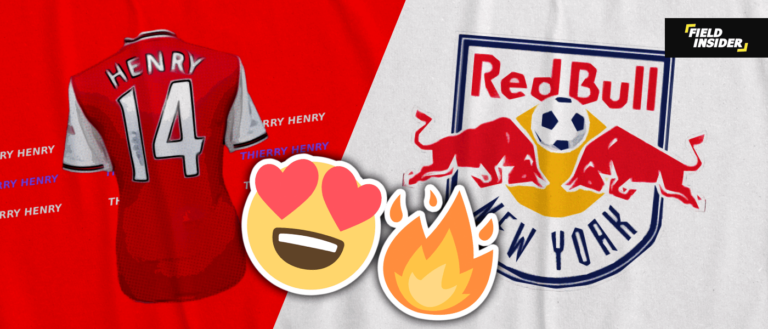What Is Gegenpressing In Football? The Complete Handbook
In the dynamic world of football, tactical innovations constantly reshape the game’s landscape. One such strategy that has significantly impacted modern football is Gegenpressing.
Originating from the Total Football philosophy, it has evolved into a staple of competitive play, adopted by the world’s leading teams and coaches.
This comprehensive guide explores the essence of Gegenpressing. It delves into its principles, tactical elements, key figures, and advantages and disadvantages. We also examine how this tactic is implemented across different leagues and its future in football.
Key Takeaways
| Aspect | Key Takeaways |
|---|---|
| Definition & Importance | Gegenpressing emphasizes immediate ball recovery, crucial for controlling the game by maintaining pressure and limiting opponent opportunities. |
| Principles | Focuses on high intensity, collective pressing, immediate reaction, and spatial awareness. |
| Tactical Elements | Involves specific formations like 4-3-3 and 3-4-3, transition phases, defensive structure, and offensive transition strategies. |
| Key Figures | Jurgen Klopp and Ralf Rangnick are instrumental in popularizing Gegenpressing, with notable success at Liverpool FC and RB Leipzig. |
| Advantages | Enhances offensive efficiency, defensive solidity, and has a psychological impact on opponents. |
| Disadvantages | Demands high physical fitness, poses a risk of counterattacks, and requires strict tactical discipline. |
| Implementation | Widely adopted in Premier League, Bundesliga, La Liga, and Serie A, tailored to each league’s style. |
| Training & Preparation | Requires comprehensive fitness conditioning, tactical drills focusing on quick transitions, psychological readiness, and effective recovery strategies. |
| Future Trends | Involves technological integration for performance analysis, tactical adaptations, and impacts on youth development and playing styles. |
Introduction of Gegenpressing

Gegenpressing: The Tactical Revolution and Its Origin
Gegenpressing, often termed counter-pressing, represents a pivotal shift in football tactics, emphasizing immediate ball recovery after loss of possession. This strategy minimizes the opponent’s opportunity to organize attacks, thereby controlling the game’s flow.
Originating from the Dutch Total Football of the 1970s, Gegenpressing has undergone significant evolution, becoming integral to the strategies of top football teams worldwide.
| Era | Development in Gegenpressing |
|---|---|
| 1970s | Dutch Total Football introduces fluidity and quick ball recovery. |
| Late 1980s | Arrigo Sacchi’s AC Milan exhibits a compact, aggressive pressing style. |
| Early 2000s | The term “Gegenpressing” emerges in Germany, notably with Ralf Rangnick. |
| 2011-2013 | Jurgen Klopp’s Borussia Dortmund perfects Gegenpressing, gains European acclaim. |
| 2015-Present | Klopp adapts Gegenpressing to English football, winning major titles with Liverpool. |
| Ongoing Evolution | Integration of technology and sports science to enhance implementation. |
Importance in Modern Football
The strategic significance of Gegenpressing in today’s game is profound. It transcends being merely a tactic; it embodies a holistic approach affecting both defense and attack.
Implementing this strategy allows teams to thwart counter-attacks effectively and command the game’s rhythm, pivotal for maintaining competitive dominance.
Gegenpressing’s efficacy shapes tactics in prestigious leagues and tournaments worldwide. Its widespread adoption and adaptation reflect its unparalleled value in contemporary football, influencing the sport at every level.
Principles of Gegenpressing
High Intensity
The principle of high intensity is fundamental to the success of Gegenpressing. It demands players exert maximum effort in short, explosive bursts, aiming to recover the ball as quickly as possible.
This relentless pursuit not only disrupts the opponent’s rhythm but also creates opportunities to exploit any disorganization in their ranks.
High intensity is a testament to a team’s physical conditioning and mental resilience. It showcase the rigorous preparation teams undergo to implement this strategy effectively. For teams and coaches looking to enhance their high-intensity play, incorporating specific fitness and conditioning routines is crucial.
Collective Pressing
Collective pressing is the embodiment of teamwork within the Gegenpressing philosophy. It requires every player on the field to engage in the press, creating a unified front against the opponent.
This approach ensures that opponents have limited space and time to make decisions, leading to forced errors and turnover opportunities. Collective pressing is not just about physical exertion; it’s a coordinated effort that relies on players’ understanding of their roles and the tactical setup of the team.
Effective implementation of this principle can be seen in formations like the 4-3-3 and 3-4-3, which facilitate aggressive pressing and team cohesion.
Immediate Reaction
Immediate reaction is the swift response required from players the moment possession is lost. This principle minimizes the opponent’s time and space. It allows the pressing team to regain control.
Immediate reaction is a blend of tactical awareness and mental readiness. Players must quickly transition from an offensive mindset to a defensive posture. This rapid shift is crucial for the success of Gegenpressing! It aims to catch opponents off guard and capitalize on their temporary vulnerability.
Spatial Awareness
Spatial awareness in Gegenpressing involves understanding and exploiting the spaces on the pitch to apply effective pressure. It requires players to recognize when and where to press, ensuring that their efforts contribute to the team’s tactical objectives.
This principle is not just about physical presence; it’s about making intelligent decisions that maximize the effectiveness of the press. Players with high spatial awareness anticipate the opponent’s moves. They position themselves to intercept passes or force mistakes.
Tactical Elements of Gegenpressing
Formation and Player Roles
The effectiveness of Gegenpressing is significantly influenced by the chosen formation and the specific roles assigned to players. Formations like the 4-3-3 or 3-4-3 are particularly conducive to this tactic, allowing for both wide and central pressing while ensuring defensive stability.
Each player’s role within these formations is meticulously defined, from the forwards’ initial press to the midfielders’ support and the defenders’ readiness to intercept or cover. This strategic alignment allows aggressive pressing without sacrificing defense.
Transition Phases
Gegenpressing thrives in transition phases, exploiting the opponent’s vulnerability immediately after losing possession. The tactic emphasizes rapid shifts from defense to attack, aiming to capitalize on the disarray within the opposing team’s ranks.
Players must quickly recognize pressing opportunities and execute coordinated moves to regain possession and launch counter-attacks for effective transition play. This aspect of Gegenpressing underscores the need for players to possess not only physical speed but also quick decision-making abilities.
Defensive Structure
While Gegenpressing is often highlighted for its offensive benefits, maintaining a solid defensive structure is equally crucial. This approach keeps the team organized and capable of thwarting counter-attacks, even as players press high up the pitch.
The defensive structure during Gegenpressing requires disciplined positioning and constant communication among players to adjust to the dynamic nature of the game.
Teams balance aggressive pressing with defensive solidity to minimize high pressing risks. This illustrates Gegenpressing’s tactical depth and complexity.
Offensive Transition
The offensive transition is a key element of Gegenpressing, where teams look to quickly turn defensive actions into scoring opportunities. This phase highlights the tactic’s dual purpose—disrupting the opponent’s play and creating chances to score.
Successful offensive transitions are marked by swift, decisive attacking moves, often catching the opponent off guard.
Seamlessly switching from pressing to attacking demands high tactical acumen, precision, creativity, and an aggressive mindset from players. Teams adept at executing these transitions can dominate games, reflecting Gegenpressing’s comprehensive impact on football strategy.
Key Figures and Teams in Gegenpressing
Jurgen Klopp
Jurgen Klopp is synonymous with the success and popularization of Gegenpressing in modern football. Teams like Borussia Dortmund and Liverpool have achieved remarkable success under his guidance, with his tactics as a gameplay cornerstone.

Klopp’s philosophy encompasses more than tactical instructions; it includes a high-energy, relentless approach demanding physical and mental resilience from players.
His ability to instill this philosophy into his teams has made them formidable opponents, known for their aggressive pressing and quick transitions. Klopp’s contribution to Gegenpressing has not only defined his career but has also left a lasting impact on football tactics worldwide.
Ralf Rangnick
Ralf Rangnick, often regarded as the “godfather” of Gegenpressing, has been instrumental in shaping the tactical landscape of football with his innovative approach. His work, particularly in Germany with teams like RB Leipzig, has demonstrated the effectiveness of disciplined, collective pressing.
Rangnick’s influence extends into the organizational structure and youth development, emphasizing the importance of a unified playing philosophy across all levels. His methodologies showcase Gegenpressing’s potential to transform teams into competitive powerhouses, inspiring a generation of coaches and players.
Liverpool FC
Liverpool FC, under Jurgen Klopp, has become the epitome of Gegenpressing success in the Premier League. Winning the Premier League and the Champions League, the team’s remarkable achievements testify to Klopp’s tactical approach’s effectiveness.
Liverpool’s playing style, characterized by intense pressing, rapid transitions, and collective teamwork, has not only entertained but also proven to be highly successful. The club’s commitment to this philosophy has set a benchmark for teams aspiring to add Gegenpressing to their tactical repertoire.
RB Leipzig
RB Leipzig’s rise in German and European football is closely linked to their adoption of Gegenpressing principles. The club’s focus on high intensity, strategic pressing, and quick transitions has enabled competition at the highest levels, despite its brief history.
Leipzig’s success story is a compelling example of how innovative tactics like Gegenpressing can level the playing field, enabling newer teams to challenge traditional powerhouses. Their tactical identity has contributed to the broader acceptance and implementation of Gegenpressing across football leagues.
Advantages and Disadvantages of Gegenpressing
Advantages
Offensive Efficiency
One of the most significant advantages of Gegenpressing is its ability to enhance a team’s offensive efficiency. By winning the ball high up the pitch, teams can exploit the disorganization in the opponent’s defensive setup, creating opportunities to score.
This method not only increases the number of scoring chances but also puts constant pressure on the opposition, often leading to mistakes that can be capitalized on.
The tactic’s emphasis on aggressive, forward-thinking play has revolutionized football strategies, making it a go-to approach for teams looking to dominate their opponents offensively.
Defensive Solidity
Despite its focus on offense, Gegenpressing also contributes to a team’s defensive solidity. By pressing aggressively, teams limit the space and time available to their opponents, reducing the likelihood of facing well-organized attacks.
This proactive defensive strategy helps in maintaining a high line, compacting the play, and minimizing the chances for opponents to break through. This creates a robust defensive posture, thwarting opposing teams and controlling the game flow, showcasing Gegenpressing’s dual benefits.
Psychological Impact
Gegenpressing exerts a significant psychological impact on opponents. The relentless pressure and high-intensity play can demoralize teams, leading to decreased confidence and increased errors.
This aspect of Gegenpressing not only disrupts the tactical plans of the opposition but also boosts the pressing team’s morale, as they gain momentum and control over the match. The psychological warfare waged through Gegenpressing can be a decisive factor in the outcome of games.
Disadvantages

Physical Demands
The physical demands of Gegenpressing are intense. Players are required to maintain high levels of fitness to execute the constant high pressing and quick transitions effectively. This requirement can lead to fatigue, increased risk of injuries, and a potential drop in performance levels over the course of a season.
The physical toll requires rigorous conditioning and careful player health and stamina management, highlighting a challenge in maintaining Gegenpressing’s effectiveness over a long campaign.
Vulnerability to Counterattacks
While Gegenpressing enhances offensive and defensive capabilities, it also presents a vulnerability to counterattacks. The high pressing style means that if the initial press is bypassed, opponents can exploit the spaces left behind, particularly if the pressing team fails to recover quickly.
This risk necessitates flawless execution and discipline from the pressing team to avoid being caught out, underlining the tactical discipline required to mitigate the dangers associated with an aggressive pressing approach.
Tactical Discipline
The success of Gegenpressing heavily relies on the tactical discipline of the team. Players must adhere strictly to their roles, maintain their positions, and execute the press as a cohesive unit.
Any lapses in discipline can lead to breakdowns in the pressing structure, offering opponents opportunities to exploit. The need for constant focus and understanding among players adds a layer of complexity to Gegenpressing, making it a challenging tactic to implement consistently at the highest level.
Implementation Across Different Leagues
Premier League
The Premier League’s fast-paced and physically demanding nature makes it an ideal environment for the application of Gegenpressing. Teams in the English top-flight have adopted this tactic to various degrees of intensity and success, leveraging the league’s emphasis on speed and endurance.
The adoption of Gegenpressing by prominent clubs has led to a noticeable shift in the tactical landscape of the Premier League. This adaptation has set a benchmark for English clubs in European tournaments, showcasing the Premier League’s tactical flexibility and innovation.
Bundesliga
In the Bundesliga, the roots of Gegenpressing can be traced back to its conceptualization, with German clubs and coaches playing pivotal roles in its development and refinement.
The tactical discipline and physicality inherent in German football provide a solid foundation for Gegenpressing, making it a widely adopted tactic across the league.
Bundesliga teams are known for their meticulous tactical preparation and physical readiness, attributes that align perfectly with the demands of Gegenpressing.
La Liga
La Liga’s technical and tactical sophistication offers a unique perspective on the implementation of Gegenpressing. Spanish clubs blend the high-intensity pressing with a strong emphasis on technical skill and possession, adapting Gegenpressing to complement their traditionally possession-based style.
This hybrid approach has allowed La Liga teams to utilize Gegenpressing not just as a defensive tool but as a means to enhance their control over the game and create attacking opportunities.
Serie A
Serie A’s tactical heritage, characterized by strategic depth and defensive organization, has embraced Gegenpressing with a focus on tactical discipline and spatial awareness.
Italian clubs have applied Gegenpressing in a manner that balances aggressive pressing with the league’s traditional emphasis on defensive solidity.
This approach has led to a nuanced adaptation of Gegenpressing, where it is used to enhance defensive structures while exploiting opportunities to press and regain possession.
Analyzing Gegenpressing’s Impact on Premier League Success
The following bar chart within our analysis presents a fascinating insight into the tactical fabric of the Premier League’s 2022/23 season, particularly focusing on Gegenpressing intensity.

It’s intriguing to observe that Manchester City, who topped the Gegenpressing charts at 57.13%, clinched the title. This suggests a strong correlation between pressing intensity and league success. Arsenal, with the third-highest intensity, secured a commendable second place, reinforcing the effectiveness of this tactic.
However, the strategy doesn’t guarantee league dominance, as indicated by Liverpool’s fifth place despite leading the Gegenpressing statistics with 59.40%. Similarly, Brighton’s impressive sixth place finish correlates with their substantial Gegenpressing effort.
On the other end, Leeds United, despite their considerable Gegenpressing intensity, found themselves in the relegation zone, finishing 19th.
This chart illustrates that while Gegenpressing can be a potent tool in a team’s arsenal, it must be balanced with other tactical elements and execution to translate into league triumphs.
Training and Preparation for Gegenpressing
Fitness and Conditioning
The physical demands of Gegenpressing necessitate a comprehensive fitness and conditioning regime tailored to enhance players’ endurance, strength, and speed.
To sustain high-intensity pressing throughout a match—and across the demanding schedule of a season—teams must invest in rigorous fitness programs.
| Drill Type | Description | Focus Area |
|---|---|---|
| High-Intensity Interval Training | Short bursts of running at maximum effort followed by recovery walking. | Stamina and Endurance |
| Small-Sided Games | 4v4 or 5v5 games in a confined space to simulate game intensity. | Match Fitness |
| Pressing Triggers Practice | Drills that initiate pressing on certain cues, like a backward pass. | Tactical Awareness |
| Sprint-Recovery Drill | Repeated sprints over short distances with brief recovery periods. | Speed and Recovery |
| Agility Ladder Drills | Quick feet exercises through an agility ladder to improve coordination. | Agility and Coordination |
These programs are designed to ensure that players can repeatedly execute quick bursts of activity, recover rapidly, and maintain optimal performance levels for longer periods.
Tactical Drills
Tactical drills play a pivotal role in preparing a team for the implementation of Gegenpressing. These drills focus on enhancing players’ understanding of their roles within the system, improving spatial awareness, and fostering seamless coordination during pressing phases.
| Drill Type | Description | Focus Area |
|---|---|---|
| Shadow Pressing | Players practice pressing movements without a ball to learn spatial awareness. | Spatial Awareness |
| Pressing in Zones | The pitch is divided into zones, and teams practice pressing in designated areas. | Zone Control |
| Counter-Pressing Scenarios | Simulated game situations where teams must immediately press after losing possession. | Quick Transition |
| Ball Recovery Races | Competitions where teams or individuals race to recover a loose ball. | Reaction Time and Speed |
| Positional Rondo | Possession games with overloads, focusing on pressing the player with the ball. | Pressing Efficiency |
Psychological Readiness
Players must also demonstrate high psychological readiness for Gegenpressing, preparing to exert maximum effort and maintain concentration throughout the game.
This mental aspect involves resilience, the ability to quickly recover from mistakes, and the willingness to press aggressively even in challenging circumstances.
Recovery Strategies
Given the intense physical exertion required by Gegenpressing, implementing effective recovery strategies is paramount for maintaining player health and performance levels throughout the season.
Recovery protocols may include post-match cooldowns, targeted physiotherapy, nutritional planning, and scheduled rest days.
Teams also use advanced recovery technologies like cryotherapy and hydrotherapy to accelerate the recovery process. These strategies are critical for managing fatigue, reducing the risk of injury, and ensuring players are physically and mentally prepared for the demands of Gegenpressing.
Future Trends and Innovations in Gegenpressing
Technological Integration
The integration of technology in football training and strategy has opened new avenues for enhancing the effectiveness of Gegenpressing. Wearable fitness trackers, GPS devices, and advanced analytics software are now commonplace, providing coaches with detailed data on player performance, stamina levels, and movement patterns.
This technological integration allows for the customization of training programs to individual player needs, optimizing physical conditioning & tactical execution.
The use of technology in refining Gegenpressing strategies underscores the sport’s evolution, emphasizing data-driven approaches to training and game planning.
Tactical Adaptations
As teams become more familiar with Gegenpressing, tactical adaptations continue to emerge, challenging its dominance and effectiveness.
Opponents develop strategies to counter high-pressing tactics, such as utilizing quick, long-ball transitions or employing possession-based approaches to mitigate pressing triggers.
In response, teams that favor Gegenpressing are evolving their tactics to include variations in pressing intensity, selective pressing, and incorporating false pressing triggers to outmaneuver opponents.
Evolution of Playing Styles
Gegenpressing has also influenced the evolution of playing styles across football, encouraging a more dynamic, high-tempo approach to the game.
This tactical philosophy has contributed to the development of players who are not only technically skilled but also possess high levels of physical fitness and tactical intelligence.
The emphasis on quick transitions and spatial awareness has led to a more versatile type of player, capable of executing complex tactical roles. The impact of Gegenpressing on playing styles demonstrates its significant influence on the sport, encouraging adaptability and tactical innovation.
Impact on Youth Development
The principles of Gegenpressing are increasingly being incorporated into youth development programs, highlighting its influence on the future of football.
Training young players in the fundamentals of high pressing, spatial awareness, and quick transitions prepares them for the tactical demands of the modern game.
Focusing on developing tactically aware, well-rounded players from a young age is reshaping youth football, emphasizing physical conditioning, mental toughness, and technical skills.
The incorporation of Gegenpressing into youth development not only prepares players for the future but also ensures the longevity and continued evolution of this tactical approach.
Conclusion
Gegenpressing has redefined modern football, blending rigorous physical demands with sharp tactical acumen. Its principles of high-intensity pressing and quick transitions have proven to be game-changers, pushing teams to adapt or fall behind.
Looking ahead, the evolution of Gegenpressing will likely intertwine with technological advancements and tactical innovations. As teams continue to seek competitive edges, the adaptation and refinement of this strategy will shape future football landscapes.











